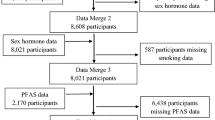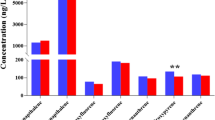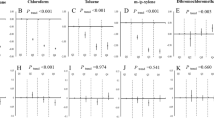Abstract
There is growing evidence suggesting that exposure to volatile organic compounds (VOCs) can pose significant health risks, including interference with the function of the reproductive system. However, there has been a lack of research focused on the impact of common environmental VOCs on the levels of sex hormones in the general female population. In this study, we conducted a cross-sectional analysis utilizing the database of the National Health and Nutrition Examination Survey (NHANES, 2013–2016). A total of 2633 participants were included in this study. The Pearson correlation model revealed the potential of co-exposure or co-toxicity between benzene and 2,5-dimethylfuran. According to GLM models, we discovered a significant positive association between blood levels of 2,5-dimethylfuran and benzene with testosterone levels in women. Subgroup analysis further identified that the women with underweight and healthy weight might be the high-risk subgroup. Bayesian kernel machine regression (BKMR) was applied to further assess the univariate and bivariate exposure–response relationships between multiple VOCs. Our research systemically formulated the possible relationship between exposure to VOCs and female sex hormones, indicating the role of VOCs as a risk factor for endocrine disruption, especially benzene and 2,5-dimethylfuran. These findings have important implications for public health and call for further investigation.




Similar content being viewed by others
Data availability
The data and materials used in this study are available upon request from the corresponding author. Access to the data and materials will be granted after a review of the request to ensure that the request is consistent with the ethical guidelines of the study and that the privacy and confidentiality of the participants are protected.
References
Ahluwalia N, Dwyer J, Terry A, Moshfegh A, Johnson C (2016) Update on NHANES dietary data: focus on collection, release, analytical considerations, and uses to inform public policy. Adv Nutr 7:121–134
Alviggi C, Guadagni R, Conforti A, Coppola G, Picarelli S, De Rosa P, Vallone R, Strina I, Pagano T, Mollo A, Acampora A, De Placido G (2014) Association between intrafollicular concentration of benzene and outcome of controlled ovarian stimulation in IVF/ICSI cycles: a pilot study. J Ovarian Res 7:67
World Medical Association (2013) World Medical Association Declaration of Helsinki: ethical principles for medical research involving human subjects. JAMA 310:2191–2194. https://doi.org/10.1001/jama.2013.281053
Anonymous (2010) WHO guidelines approved by the guidelines review committee, WHO guidelines for indoor air quality: selected pollutants. World Health Organization Copyright © 2010, World Health Organization, Geneva
Bahadar H, Mostafalou S, Abdollahi M (2014) Current understandings and perspectives on non-cancer health effects of benzene: a global concern. Toxicol Appl Pharmacol 276:83–94
Bobb JF, Valeri L, Claus Henn B, Christiani DC, Wright RO, Mazumdar M, Godleski JJ, Coull BA (2015) Bayesian kernel machine regression for estimating the health effects of multi-pollutant mixtures. Biostatistics (oxford, England) 16:493–508
Brito JM, Belotti L, Toledo AC, Antonangelo L, Silva FS, Alvim DS, Andre PA, Saldiva PH, Rivero DH (2010) Acute cardiovascular and inflammatory toxicity induced by inhalation of diesel and biodiesel exhaust particles. Toxicol Sci 116:67–78
Castellanos M, Suñer R, Fernández-Real JM, Sanchez JM (2019) 2,5-Dimethylfuran as a validated biomarker of smoking status. Nicotine Tob Res 21:828–834
Chaiklieng S, Suggaravetsiri P, Autrup H (2019) Risk assessment on benzene exposure among gasoline station workers. Int J Environ Res Public Health 16(14). https://doi.org/10.3390/ijerph16142545
Chambers DM, Reese CM, Thornburg LG, Sanchez E, Rafson JP, Blount BC, Ruhl JRE 3rd, De Jesús VR (2018) Distinguishing petroleum (crude oil and fuel) from smoke exposure within populations based on the relative blood levels of benzene, toluene, ethylbenzene, and xylenes (BTEX), styrene and 2,5-dimethylfuran by pattern recognition using artificial neural networks. Environ Sci Technol 52:308–316
Cho SI, Damokosh AI, Ryan LM, Chen D, Hu YA, Smith TJ, Christiani DC, Xu X (2001) Effects of exposure to organic solvents on menstrual cycle length. J Occup Environ Med 43:567–575
Davis SR, Wahlin-Jacobsen S (2015) Testosterone in women–the clinical significance. Lancet Diabetes Endocrinol 3:980–992
De Celis R, Feria-Velasco A, González-Unzaga M, Torres-Calleja J, Pedrón-Nuevo N (2000) Semen quality of workers occupationally exposed to hydrocarbons. Fertil Steril 73:221–228
Grino PB, Griffin JE, Wilson JD (1990) Testosterone at high concentrations interacts with the human androgen receptor similarly to dihydrotestosterone. Endocrinology 126:1165–1172
Hammes SR, Levin ER (2019) Impact of estrogens in males and androgens in females. J Clin Invest 129:1818–1826
Han L, Wang J, Zhang L, Jing J, Zhang W, Liu Z, Gao A (2023) The role of N(6)-methyladenosine modification in benzene-induced testicular damage and the protective effect of melatonin. Chemosphere 319:138035
He C, Cheng J, Zhang X, Douthwaite M, Pattisson S, Hao Z (2019) Recent advances in the catalytic oxidation of volatile organic compounds: a review based on pollutant sorts and sources. Chem Rev 119:4471–4568
Huang B, Lei C, Wei C, Zeng G (2014) Chlorinated volatile organic compounds (Cl-VOCs) in environment - sources, potential human health impacts, and current remediation technologies. Environ Int 71:118–138
Kabir ER, Rahman MS, Rahman I (2015) A review on endocrine disruptors and their possible impacts on human health. Environ Toxicol Pharmacol 40:241–258
Kaliannan K, Robertson RC, Murphy K, Stanton C, Kang C, Wang B, Hao L, Bhan AK, Kang JX (2018) Estrogen-mediated gut microbiome alterations influence sexual dimorphism in metabolic syndrome in mice. Microbiome 6:205
Keevil BG, Adaway J (2019) Assessment of free testosterone concentration. J Steroid Biochem Mol Biol 190:207–211
Kumar S, Sharma A, Kshetrimayum C (2019) Environmental & occupational exposure & female reproductive dysfunction. Indian J Med Res 150:532–545
Laothawornkitkul J, Taylor JE, Paul ND, Hewitt CN (2009) Biogenic volatile organic compounds in the Earth system. New Phytol 183:27–51
Lemasters GK, Olsen DM, Yiin JH, Lockey JE, Shukla R, Selevan SG, Schrader SM, Toth GP, Evenson DP, Huszar GB (1999) Male reproductive effects of solvent and fuel exposure during aircraft maintenance. Reprod Toxicol 13:155–166
Leroux A, Di J, Smirnova E, McGuffey EJ, Cao Q, Bayatmokhtari E, Tabacu L, Zipunnikov V, Urbanek JK, Crainiceanu C (2019) Organizing and analyzing the activity data in NHANES. Stat Biosci 11:262–287
Li W, Ruan W, Cui X, Lu Z, Wang D (2022) Blood volatile organic aromatic compounds concentrations across adulthood in relation to total and cause specific mortality: A prospective cohort study. Chemosphere 286(Pt 1):131590. https://doi.org/10.1016/j.chemosphere.2021.131590
Liu N, Feng Y, Luo X, Ma X, Ma F (2022) Association between dietary inflammatory index and sex hormone binding globulin and sex hormone in U.S. adult females. Front Public Health 10:802945
Long SE, Kahn LG, Trasande L, Jacobson MH (2021) Urinary phthalate metabolites and alternatives and serum sex steroid hormones among pre- and postmenopausal women from NHANES, 2013–16. Sci Total Environ 769:144560
Mandani P, Desai K, Highland H (2013) Cytotoxic effects of benzene metabolites on human sperm function: an in vitro study. ISRN Toxicol 2013:397524
Montero-Montoya R, Lopez-Vargas R, Arellano-Aguilar O (2018) Volatile organic compounds in air: sources, distribution, exposure and associated illnesses in children. Ann Glob Health 84:225–238
Rosati MV, Sancini A, Tomei F, Sacco C, Traversini V, De Vita A, De Cesare DP, Giammichele G, De Marco F, Pagliara F, Massoni F, Ricci L, Tomei G, Ricci S (2017) Correlation between benzene and testosterone in workers exposed to urban pollution. Clin Ter 168:e380–e387
Salthammer T, Zhang Y, Mo J, Koch HM, Weschler CJ (2018) Assessing human exposure to organic pollutants in the indoor environment. Angew Chem Int Ed Engl 57:12228–12263
Sirotkin A, Záhoranska Z, Tarko A, Popovska-Percinic F, Alwasel S, Harrath AH (2020) Plant isoflavones can prevent adverse effects of benzene on porcine ovarian activity: an in vitro study. Environ Sci Pollut Res Int 27:29589–29598
Sirotkin AV, Macejková M, Tarko A, Fabova Z, Alrezaki A, Alwasel S, Harrath AH (2021) Effects of benzene on gilts ovarian cell functions alone and in combination with buckwheat, rooibos, and vitex. Environ Sci Pollut Res Int 28:3434–3444
Thurston SW, Ryan L, Christiani DC, Snow R, Carlson J, You L, Cui S, Ma G, Wang L, Huang Y, Xu X (2000) Petrochemical exposure and menstrual disturbances. Am J Ind Med 38:555–564
Vardoulakis S, Giagloglou E, Steinle S, Davis A, Sleeuwenhoek A, Galea KS, Dixon K, Crawford JO (2020) Indoor exposure to selected air pollutants in the home environment: a systematic review. Int J Environ Res Public Health 17. https://doi.org/10.3390/ijerph17238972
Villeneuve PJ, Jerrett M, Brenner D, Su J, Chen H, McLaughlin JR (2014) A case-control study of long-term exposure to ambient volatile organic compounds and lung cancer in Toronto, Ontario, Canada. Am J Epidemiol 179:443–451
Webb E, Bushkin-Bedient S, Cheng A, Kassotis CD, Balise V, Nagel SC (2014) Developmental and reproductive effects of chemicals associated with unconventional oil and natural gas operations. Rev Environ Health 29:307–318
Wei C, Cao L, Zhou Y, Zhang W, Zhang P, Wang M, Xiong M, Deng C, Xiong Q, Liu W, He Q, Guo Y, Shao Z, Chen X, Chen Z (2022a) Multiple statistical models reveal specific volatile organic compounds affect sex hormones in American adult male: NHANES 2013–2016. Front Endocrinol (lausanne) 13:1076664
Wei C, Chen Y, Yang Y, Ni D, Huang Y, Wang M, Yang X, Chen Z (2022b) Assessing volatile organic compounds exposure and prostate-specific antigen: National Health and Nutrition Examination Survey, 2001–2010. Front Public Health 10:957069
Wei C, Tian L, Jia B, Wang M, Xiong M, Hu B, Deng C, Hou Y, Hou T, Yang X, Chen Z (2022c) Association between Serum Triglycerides and Prostate Specific Antigen (PSA) among U.S. Males: National Health and Nutrition Examination Survey (NHANES), 2003-2010. Nutrients 14(7). https://doi.org/10.3390/nu14071325
Wilson JD (1972) Recent studies on the mechanism of action of testosterone. N Engl J Med 287:1284–1291
Xiao G, Pan C, Cai Y, Lin H, Fu Z (2001) Effect of benzene, toluene, xylene on the semen quality and the function of accessory gonad of exposed workers. Ind Health 39:206–210
Ye D, Klein M, Chang HH, Sarnat JA, Mulholland JA, Edgerton ES, Winquist A, Tolbert PE, Sarnat SE (2017) Estimating acute cardiorespiratory effects of ambient volatile organic compounds. Epidemiology 28:197–206
Yilmaz B, Terekeci H, Sandal S, Kelestimur F (2020) Endocrine disrupting chemicals: exposure, effects on human health, mechanism of action, models for testing and strategies for prevention. Rev Endocr Metab Disord 21:127–147
Author information
Authors and Affiliations
Contributions
Chengcheng Wei: conceptualization, data curation, formal analysis, methodology, software, visualization, writing—original draft, writing—review and editing. Yao Pan: conceptualization, methodology, writing—review and editing. Wenting Zhang: validation, writing—review and editing. Qingliu He, Zhaohui Chen, and Yuan Zhang: conceptualization, funding acquisition, methodology, supervision, writing—review and editing. Chiyue Hu: article revision.
Corresponding author
Ethics declarations
Ethical approval
The NHANES data used in this study had already received approval from the NAHNES Institutional Review Board (IRB)/NCHS Research Ethics Review Board (ERB), and therefore, our study does not require additional approval. The present study was also conducted in accordance with the ethical guidelines of the Declaration of Helsinki.
Consent to participate
Informed consent was obtained from all participants prior to their participation in the study. The consent form explained the purpose of the study, the procedures involved, and the risks and benefits of participation. Participants were also informed that their participation was voluntary and that they could withdraw at any time without penalty.
Consent for publication
All participants were informed that the results of the study may be published in academic journals or presented at academic conferences. They were also informed that their identities would be kept confidential and that their personal information would not be disclosed in any publication or presentation.
Competing interests
The authors declare no competing interests.
Additional information
Responsible Editor: Lotfi Aleya
Publisher's note
Springer Nature remains neutral with regard to jurisdictional claims in published maps and institutional affiliations.
Supplementary Information
Rights and permissions
Springer Nature or its licensor (e.g. a society or other partner) holds exclusive rights to this article under a publishing agreement with the author(s) or other rightsholder(s); author self-archiving of the accepted manuscript version of this article is solely governed by the terms of such publishing agreement and applicable law.
About this article
Cite this article
Wei, C., Pan, Y., Zhang, W. et al. Comprehensive analysis between volatile organic compound (VOC) exposure and female sex hormones: a cross-sectional study from NHANES 2013–2016. Environ Sci Pollut Res 30, 95828–95839 (2023). https://doi.org/10.1007/s11356-023-29125-0
Received:
Accepted:
Published:
Issue Date:
DOI: https://doi.org/10.1007/s11356-023-29125-0





